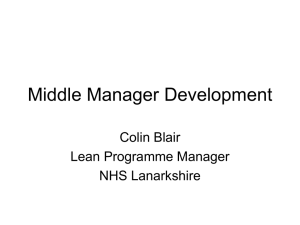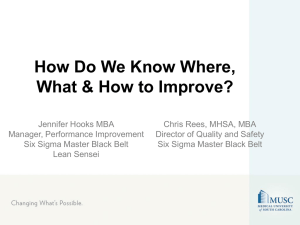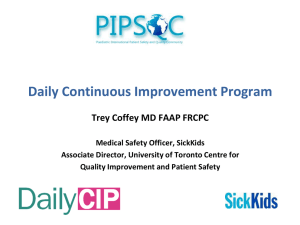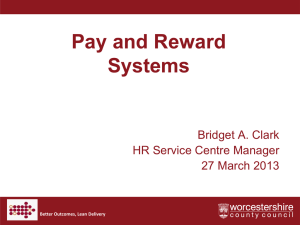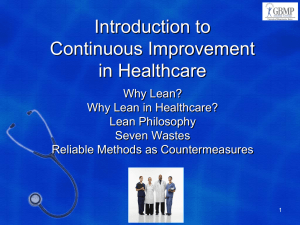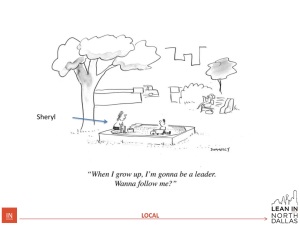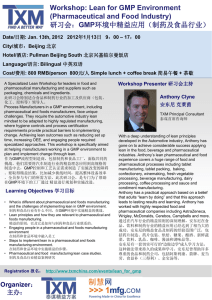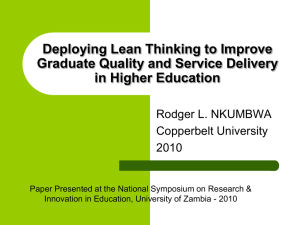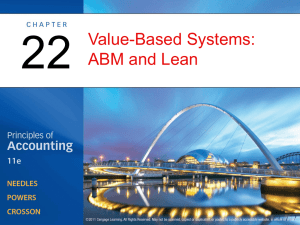Lean is… - Northwest Missouri State University
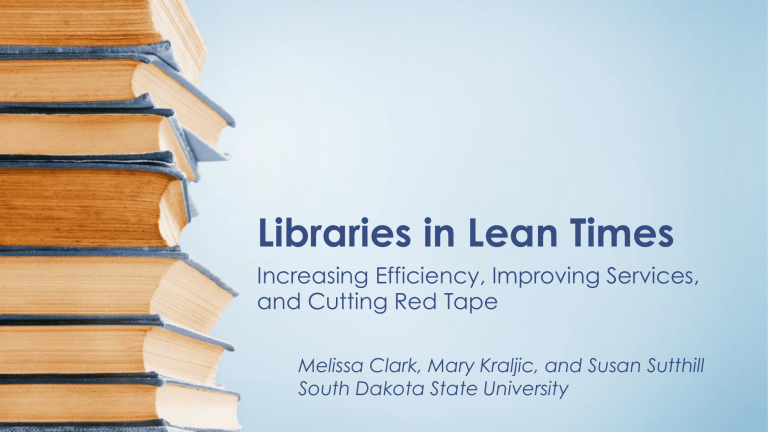
Libraries in Lean Times
Increasing Efficiency, Improving Services, and Cutting Red Tape
Melissa Clark, Mary Kraljic, and Susan Sutthill
South Dakota State University
Why You Should Care
What is Lean?
Lean is…
An approach developed to refine manufacturing processes by
Reducing waste (in terms of time, energy, and resources)
Streamlining operations
Increasing efficiency
Maximizing value for customers
Five Principles of Lean
1. Specify value as defined by the customer whose needs are served by this work process, analyze all activities from the customer’s point of view, and identify any wasted effort that does not serve the customer’s needs.
2. Identify a value stream by using flow charts or other tools to examine every step, to categorize each step as either value-added or non-valueadded, and to eliminate blatantly wasteful steps.
3. Generate flow in the process to prevent bottlenecks and batching.
4. Utilize pull processing (Just-In-Time processing) practices.
5. Pursue perfection through continual review and improvement of the process
(Womack and Jones 16-26)
Lean in Libraries…
Can be used to build employee confidence and increase their capacity for change
(Tornquist and Steinlicht 2)
Types of Waste
People Waste
“refers to the category of wastes that occurs when universities fail to capitalize fully on the knowledge, skills, and abilities of employees and workgroups” (Huber
184)
Process Waste
“refers to the cluster of wastes that occurs due to shortcomings in the design or implementation of university processes”
(Huber 186)
Types of Waste (cont.)
Information Waste Asset Waste
“refers to the category of wastes that occurs when available information is deficient for supporting university processes” (Huber 191)
“refers to the cluster of wastes that occurs when the university does not use its resources (human, facilities, and materials) in the most effective manner” (Huber 194)
…
Librarian pulls each item off the cart for review
Why have a
Librarian do this?
Rec.
Weeding?
No
Why are we using paper
Yes
Librarian gets a weeding slip and fills out the relevant sections forms?
…
…
…
Look for book in stacks
Found?
No
Yes
Check once/month for 1 year
Why search so long?
Search again?!
…
Look one more time
…
Searching for Simplicity
Lean and Lost Book
Handling
First step…a hardy breakfast!
Training to get “lean.” Briggs Library volunteers meet for breakfast.
Why Lost Book Handling?
Affected all library units
Lacked written procedures
Had a backlog of lost & missing items
Affected accuracy of the catalog and patron accessibility to materials
Next steps…
11 staff members; 4 half-days; Jan.-May
2013
Detailed all possible outcomes for a Book identified as lost or missing
Whiteboard lists and Post-it notes
Flow charts
Before
Bursts represent dead ends or uncertainties
4 Similar Processes Analyzed
Missing books – not on loan, not on shelf
Lost books – reported as lost, or missing for a year
Long overdue books - not yet billed, replaced or removed from the catalog
“Claimed Returned” books
3 subcommittees tackled them in painstaking detail.
After
After
Significant Discoveries
Many steps missing from written procedures
Long waits for materials found in catalog
Lost items, lost far too long
Search & Notify process
slow, duplicate efforts, unnecessary steps
Significant Changes
Complete set of written procedures
Immediate ILL for lost or missing items
Faster turnaround for lost or missing items: search for 6 months, then replace or remove from the catalog
Disappearing backlog of lost and long overdue items
Paperless Search & Notify
Shaping Up and Slimming Down
Lean and Weeding
Why Apply Lean to Weeding?
The collections desperately needed weeding, however
Existing procedures were incomplete
Process was complicated and lengthy
No inducement to carry it through to completion
Weeding became low priority
Identifying Value
Remove outdated materials
Remove materials that no longer support the
University’s programs
Make it easier for patrons to locate suitable resources
Ensure the collections are aligned with the teaching and research priorities of the University
Processes Analyzed
Circulating collections
Main circulating collection
Oversize collection
Audio/visual collection
Reference materials that are new editions on standing order
Reference materials that are new editions not on standing order
Reference materials that are not new editions
Identifying the Wastes
Critical differences existed for each of the different collections’ weeding procedures
Items remained on weeding review until reviewed by the required librarian, sometimes as long as a year
Filling out handwritten weeding and relocation slips was tedious and prone to error
Expectations for assigned subject areas were not established
Applying Lean Principles
Aligned procedures for different collections to minimize the differences between them
Limited the amount of time for review to 3 weeks
Replaced handwritten slips with a spreadsheet populated by information from the ILS
Shifted repetitive and simple tasks to student assistants
• Required only the subject librarian to approve relocation of items
• Required only two librarians to approve weeding of items
• Assigned each LC subclass to a pair of librarians to ensure equal responsibility and attention
• Assigned oversight to the Head of Public Services
Implementation and Results
• Piloting currently in process
• Full implementation set to roll out in the coming weeks
Our Insights and Recommendations for
Trimming Down
Employing Lean in
Your Library
Collaboration is Essential
Most library processes affect multiple departments and require teamwork
Ex. Reshelving of returned materials by Stacks personnel requires they first be checked in by Circulation staff
All departments’ needs and concerns need to be addressed in a Lean review
Also including ‘outsiders’ in the review can be very beneficial
May be better equipped to spot waste and question long-held practices
Collaborative Nature of the Process:
The Opportunities
Work with different people
Build working relationships
Learn about different library processes and workflows
Develop greater appreciation for coworkers and the work they do
Foster enthusiasm for the change and help overcome any resistance
Distributed sessions give time for reflection
Collaborative Nature of the Process:
The Risks
Dependent on the goodwill and engagement of many people
Fear of losing status or becoming unnecessary can complicate
Ideally will not ‘downsize,’ but shift time and assets to where they are most beneficial
Potential for personality conflicts
Defensive reactions to wastes identified in someone’s workflow
Project mission drift
Scheduling issues
Questions?
Works Cited
Alexander, Gwen, and John H. Williams. "The Impact of an
Accelerated Improvement Workshop on Ordering and
Receiving." Library Collections, Acquisitions, & Technical Services
29.3 (2005): 283-94. EBSCO MegaFILE. Web. 5 June 2014.
Armstrong-Viner, Robin. "Lean Kaizen: Empowering the Team in
Interesting Times." Catalogue & Index 161 (2010): 16-20. Web. 4
June 2014.
Cother, C. "From Big Change to No Change: Discovering Lean through Action." IATUL Proceedings, New Series (2009): n. pag.
Purdue e-Pubs. Web. 4 June 2014.
Glusker, Ann. "Implementing the Transition from Full- to Self-Service
Table of Contents Alerts: A Case Study." Journal of Hospital
Librarianship 13.1 (2013): 1-10. Web. 4 June 2014.
Grice, Daisy, and Jane Martel. "CALCON 2012 - Lean Material
Processing: Work Smarter, Not Harder." Colorado Libraries 36.4
(2013): n. pag. Web. 4 June 2014.
Hilton M. Briggs Library. Strategic Plan: July, 2013. Briggs Library, 2013.
Web. 25 June 2014. PDF file.
Huber, John J. Lean Library Management: Eleven Strategies for
Reducing Costs and Improving Customer Services. New York:
Neal-Schuman, 2011. Print.
Kress, Nancy J. "Lean Thinking in Libraries: A Case Study on Improving
Shelving Turnaround." Journal of Access Services 5.1-2 (2007): 159-
72. Web. 4 June 2014.
Murphy, Sarah Anne. "Leveraging
Lean
Six Sigma to Culture, Nurture, and Sustain Assessment and Change in the Academic Library
Environment." College & Research Libraries 70.3 (2009): 215-25.
Web. 4 June 2014.
South Dakota State University. Facts 2013-2014. SDSU, 2013. Web. 18
June 2014. PDF file.
---. (2013). “Goal 4: High-Performing University.” sdstate.edu. SDSU,
2013. Web. 25 June 2014.
Spagnolo, Lisa. "Give a Little Bit: Using Lean Tools to Create
Efficiencies in Acquisitions and Beyond." Proceedings of the
Charleston Library Conference (2011): 483-87. Purdue e-Pubs.
Web. 23 June 2014.
Tornquist, Kristi and Carrie Steinlicht. Lean Serendipity. Mountain Plains
Library Association, 2013. Web. 19 June 2014. PDF file.
Tuai, Cameron K. "Implementing Process Improvement Into Electronic
Reserves: A Case Study." Journal of Interlibrary Loan, Document
Delivery & Electronic Reserves 16.4 (2006): 113-24. Academic
Search Premier. Web. 4 June 2014.
Womack, James P., and Daniel T. Jones. Lean Thinking: Banish Waste
and Create Wealth in Your Corporation. New York: Free Press,
2003. Print.


